Engineering problems are under-defined, there are many solutions, good, bad and indifferent. The art is to arrive at a good solution. This is a creative activity, involving imagination, intuition and deliberate choice.
-Ove Arup
Solution Management
Solution Management is responsible for defining and supporting the building of desirable, feasible, viable, and sustainable large-scale business solutions that meet customer needs.
Those responsible for this function achieve this by collaborating with a wide range of people to identify and define customer needs, understand the Solution Context, and develop the Solution Vision, Solution Roadmap, and the Capabilities required to meet them. Working with Solution Architect/Engineering, Solution Management aligns the Solution Train’s ARTs and Suppliers on what to build and how to build it by establishing the Solution Intent repository. They also play a critical role in solution train events including Pre- and Post-PI planning, Solution and System Demos, Solution Train Sync, and the ART and solution train Inspect and Adapt (I&A) Workshops.
Details
As shown in Figure 1, Solution Management works directly with Product Management to define the various aspects of the solution. They also collaborate with Solution Architect/Engineering to collaboratively design the solution and assure technical feasibility.
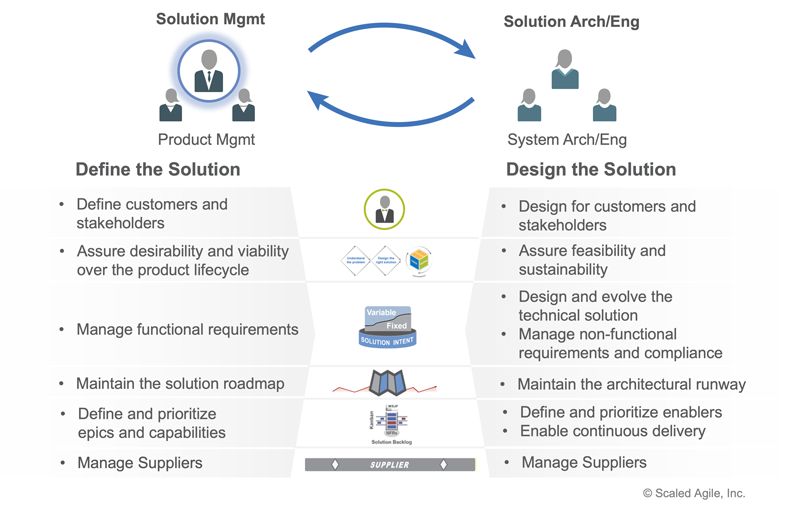
The Product Management article describes Product Management’s responsibilities within an ART context, where they are responsible for defining and building a solution that meets business goals. In a Solution Train, Product Management is part of the larger Solution Management team where they share those responsibilities.
This article describes the additional Solution Management responsibilities necessary for building large solutions, as highlighted on the left side of Figure 1.
Define Customers and Stakeholders
As with Product Management, a Customer-Centric mindset drives Solution Management and places the customer at the center of every decision. Supported by the tools and techniques of Design Thinking, this mindset focuses the entire solution development and supply chain on creating desirable, viable, feasible, and sustainable solutions. Solution Management works with the extended Product Management team and suppliers to:
- Define customers and stakeholders – Large solutions interact with a broad set of customers and stakeholders. These may include end-users, operations, manufacturing, suppliers, and other Development Value Streams (DVS) in the extended supply chain. Solution Management engages with the people in these roles to ensure the solution addresses their individual needs.
- Maintain design-thinking assets – To better connect with customers and stakeholders, Solution Management works with Product Management to create and maintain relevant personas, empathy maps, and journey maps.
Assure Desirability and Viability Over the Product Lifecycle
Many large solutions remain in use for decades. Traditionally, a project-based approach to development would fund the initial system development. Later enhancements would require a ‘modernization effort,’ with separate budgeting and, in many cases, a different development team. A contemporary, product-centric approach to development continuously aligns solution development with the portfolio roadmap and budgeting process. New development, support, enhancements, operation, and innovative experiments are all conducted by long-lived teams of teams. These teams build the solution and the Continuous Delivery Pipeline (CDP) infrastructure necessary to evolve the solution continuously. When applied at scale, the complexities of these activities lead to critical leadership responsibilities for Solution Management (Figure 2).
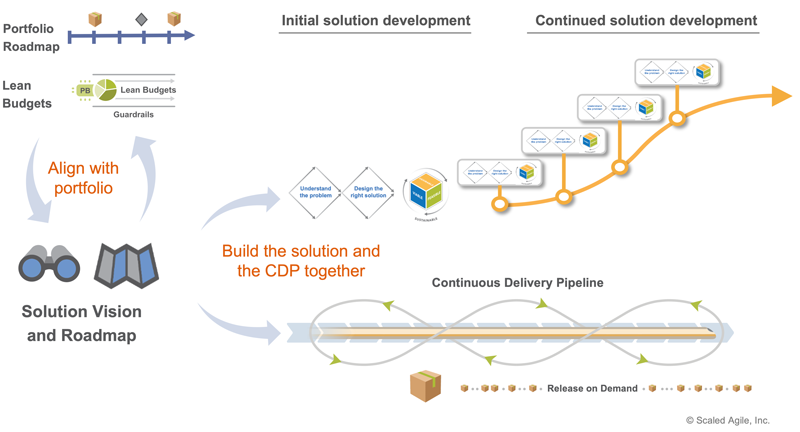
As Figure 2 illustrates, Solution Management’s additional responsibilities include:
- Align the solution roadmap with the portfolio roadmap – Larger solutions require more significant investments and, therefore, increased attention from Lean Portfolio Management (LPM). Solution Managers help assure that the portfolio roadmap is current with relevant Milestones, Releases, and Epics identified on the solution roadmap.
- Communicate investment needs with LPM –Solution Management also helps assure portfolio managers understand solution investment needs and communicates them at portfolio events, including Participatory Budgeting and Strategic Portfolio Reviews.
- Evolve solution’s vision and roadmap – Solution Management tracks changing business and customer/stakeholder needs and— in conjunction with Solution Architect/Engineering— the impact of emerging technology. The solution vision and long-term roadmap are constantly adjusted to reflect these realities.
- Invest in the Continuous Delivery Pipeline –Solution Management prioritizes proper investment into the Continuous Delivery Pipeline (CDP) so that the solution remains viable and affordable to evolve, support, and operate over its extended lifecycle.
- Continually release the solution – With LPM’s continuous funding model and a continuous delivery pipeline in place, Solution Managers can change their approach to launching solutions. Instead of deploying these systems once and supporting them, they deploy them early and evolve them continually.
Manage Functional Requirements
The traditional approach to managing requirements for large solutions has been to create an exhaustive set of specifications early in the solution lifecycle. But today’s innovative solutions are developed in a context of too much technical and market uncertainty—and indeed too much future opportunity—to fix these decisions so early in development. Instead, requirements should evolve based on the learning that occurs during development (see Design and Evolve Specifications in Solution Architect/Engineering [coming soon]).
In SAFe, Solution Managers use Solution Intent to manage requirements and apply a fixed vs. variable approach to specifying them. They establish:
- The flexible requirements and design constraints necessary to communicate intent to system builders (e.g., system functionality, resource allocations, performance, etc.)
- Compliance needs (e.g., ensure conformity to specifications)
- The fixed specifications necessary to communicate with traditional (not Agile) suppliers.
In place of traditional, detailed specifications, Solution Managers delegate the requirement details to the ARTs’ and teams’ backlogs which are elaborated at the appropriate time by the people doing the work (Figure 3).
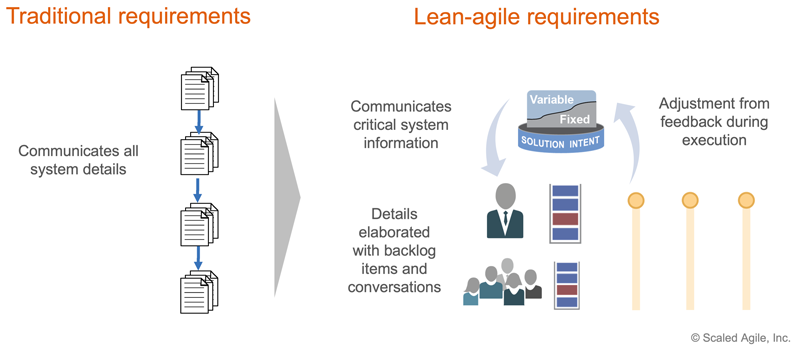
Steps in this process include:
- Define and manage requirements in the solution intent. In collaboration with Solution Architect/Engineering, Solution Management defines and evolves the requirements that the solution must meet, including functional and Nonfunctional Requirements (NFR). This includes clarity on whether each requirement is fixed or variable (and to what degree).
- Decompose requirements – Requirements may be further decomposed into subsystem requirements to communicate intent with internal and external suppliers and support compliance needs. This process is repeated recursively, as necessary, to provide the information needed to build and validate the complete solution.
- Evolve requirements based on feedback – As they implement the solution, teams and ARTs evolve the requirements (see the feedback arrow in Figure 3). Some adjustments are anticipated as variable requirements become fixed at the time of implementation. Others will be unexpected, and Solution Management makes these tradeoff decisions after consulting with appropriate stakeholders.
Maintain the Solution Roadmap
At scale, the development value streams (DVS) that build solutions may deliver these solutions to other DVSs. Solution Management maintains a solution roadmap to inform stakeholders of expectations and establish various progress milestones (Figure 4).
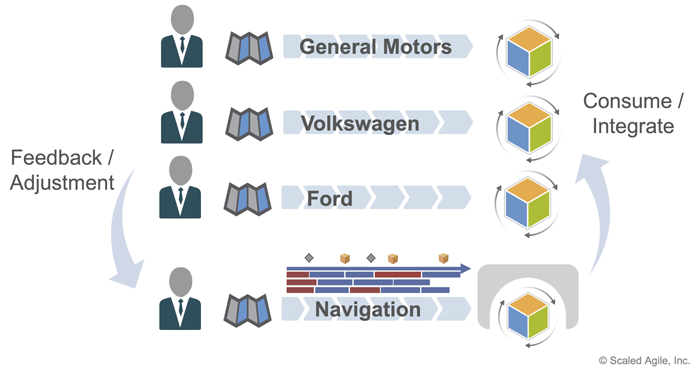
To do so, they:
- Balance the needs of multiple customers – Solutions may serve many customers who rely on new functionality to deliver their solutions. Solution Management weighs the needs of these customers to ensure the best overall outcomes. SAFe’s participatory budgeting and Weighted Short Job First (WSJF) practices provide a transparent, inclusive approach to prioritizing all stakeholder work. The solution’s vision and roadmap also offer transparency, allowing dependent DVSs to plan accordingly and helping to reduce the inherent tension. (note: See the ‘Manage the supply chain with systems of systems thinking’ section of Enterprise Solution Delivery for different approaches to supporting multiple stakeholders.)
- Align the solution roadmap – Solution Management frequently collaborates with these and other stakeholders across the supply chain to keep their roadmaps aligned as the solution evolves.
Define and Prioritize Epics and Capabilities
Solution Management is responsible for defining and prioritizing the epics and capabilities needed to advance the solution (Figure 5).
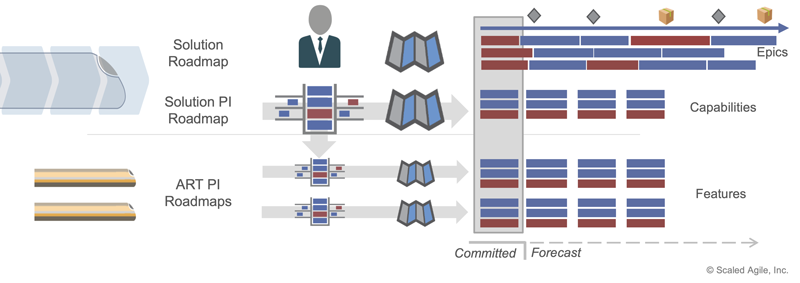
To do this, Solution Management must:
- Define epics and capabilities – Based on the solution vision, solution managers define the epics and capabilities that drive the backlogs for the solution train’s ARTs and suppliers.
- Move epics and capabilities through the solution Kanban – Solution managers manage the solution train’s Work in Process (WIP) with the Solution Kanban system. As work flows through the solution Kanban, it informs the work that is captured in the solution PI roadmap and the ART’s Program Kanban systems.
- Maintain the solution’s PI roadmap – Solution Management forecasts future capabilities in the PI roadmap, driven primarily by the solution roadmap. The forecast length will vary from a few PIs to possibly multiple years. The near-term PI roadmaps for large solutions are often reasonably full for alignment and tracking across the large supply chain. The roadmap is adjusted during each PI planning session.
Manage Suppliers
To accelerate delivery times and reduce costs, system builders typically rely on suppliers for their unique competencies, skills, and specialty system components. This requires Solution Managers to:
- Select suppliers – In conjunction with Solution Architect/Engineering, Solution Management chooses suppliers that can deliver the best long-term value and support collaborative Lean-Agile development practices. As Suppliers have unique and often untapped expertise, Solution Management includes their input when creating system specifications and ensures the specifications allow sufficient flexibility during implementation.
- Align suppliers – While the ideal supplier will operate and be aligned with standard SAFe practices, including PI planning, system demos, road-mapping and more, some will not. Suppliers that work in a more traditional model with up-front specifications and delivery dates must still be supported. In these cases, Solution Management must provide the appropriate specifications and updates the supplier’s scope of work to reflect changes as the solution, and the roadmap evolve.
Last update: 7 May 2021





